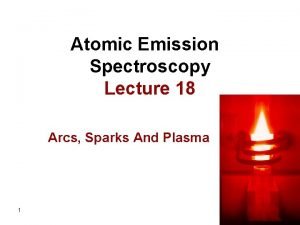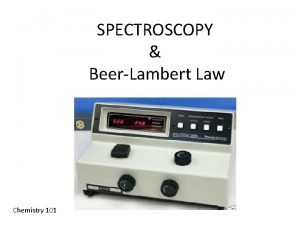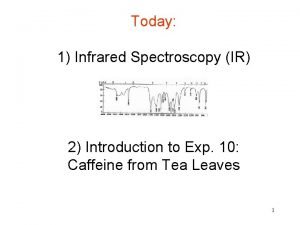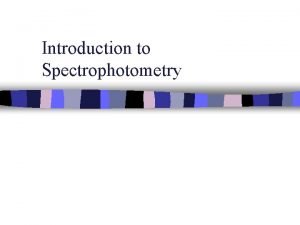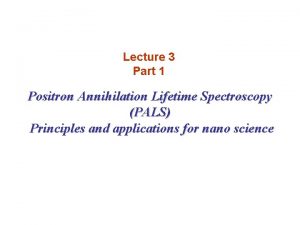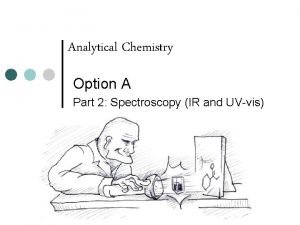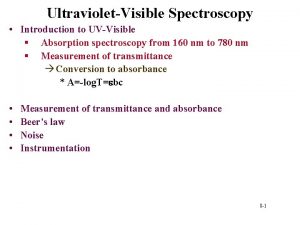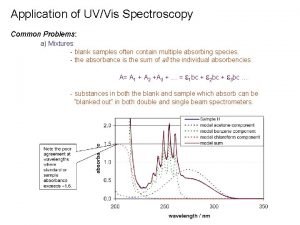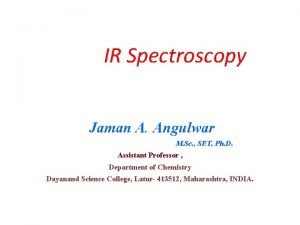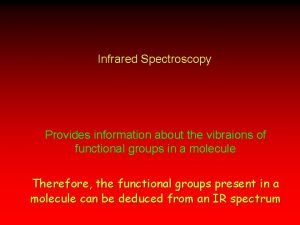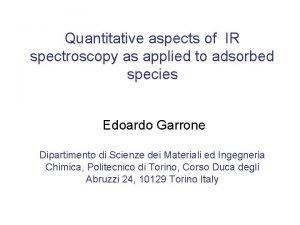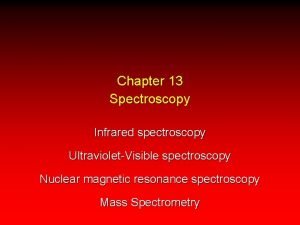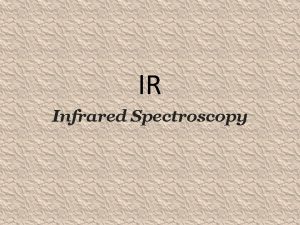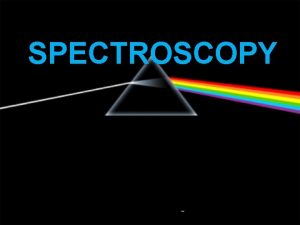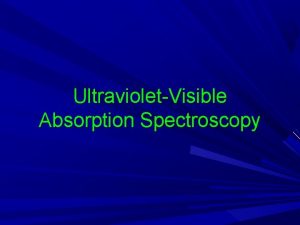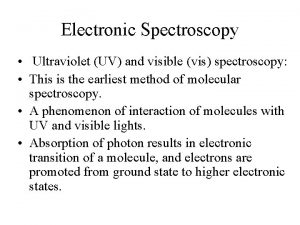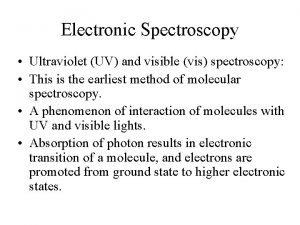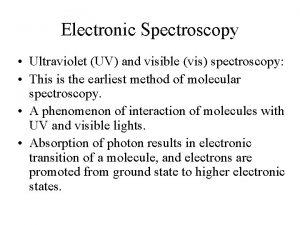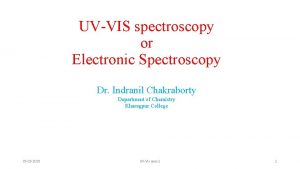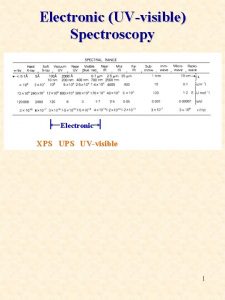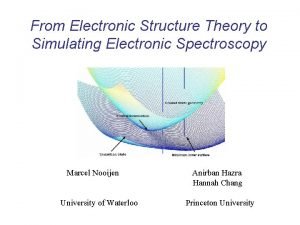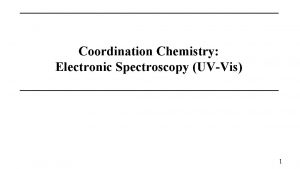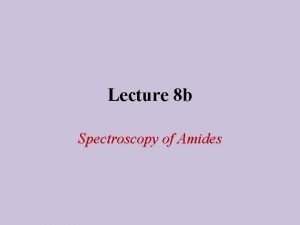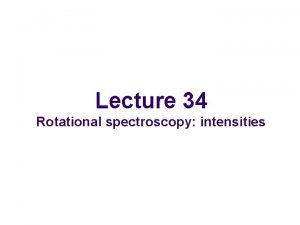Lecture 36 Electronic spectroscopy Electronic spectroscopy l l




















- Slides: 20

Lecture 36 Electronic spectroscopy

Electronic spectroscopy l l l Transition energies between electronic states fall in the range of UV/vis photons. UV/vis or optical or electronic absorption spectroscopy determines the electronic energy levels and, therefore, electronic excited state structure and dynamics. Vibrational energy levels and structures of electronic excited states can be obtained from the Franck-Condon progression. We will also consider cases where the Franck. Condon principle breaks down and vibronic coupling must be taken into account.

Electronic absorption l Transition dipole moment: Born-Oppenheimer separation Electronic Vibrational transition overlap moment (not zero) Zero

Franck-Condon factor Intensity Franck–Condon factor Franck-Condon or vibrational progression 0 -0 transition Electronic (UV/vis) spectra give not only electronic excitation energies but also vibrational frequencies in excited states

Progression pattern 1 Short progression dominated by 0 -0 transition suggests that the two PES (electronic states) have similar equilibrium structures and similar vibrational frequencies (bond strengths) This in turn implies that the excited electron has likely vacated a nonbonding or weaker π orbital.

Progression pattern 2 Long progression with a weak 0 -0 transition suggests that the two PES (electronic states) have very different equilibrium structures. This in turn implies that the excited electron has likely vacated a bonding σ orbital, significantly weakening the bonds and changing the molecular structure.

Progression pattern 2 (continued) The molecule is vertically excited to a new, upper PES (cf. classical-quantum correspondence in harmonic oscillator). The molecule finds itself far from the new equilibrium structure and starts to vibrate back to it. The vibration is along the totally -symmetric structure change from the ground to excited state.

Progression pattern 3 Long progression with alternating intensities suggests that the two PES (electronic states) have similar equilibrium structures but very different vibrational frequencies. This may occur for non-totallysymmetric vibrations which may change their frequencies upon electronic excitations, but no structure change can occur along the corresponding nontotally-symmetric coordinate.

Progression pattern 4 Progression with a blurred structure suggests that the upper PES (electronic state) becomes dissociative where the blurring starts.

Fluorescence (emission) spectroscopy Pump energy to the molecule so it gets electronically excited The molecule loses energy to its surrounding non-radiatively and reaches the ground vibrational state of electronic excited state Michael Kasha (Kasha’s rule). The molecule makes a radiative transition (fluoresce) (cf. Einstein’s spontaneous emission or radiation). Franck-Condon progression is observed.

Fluorescence quenching Molecules prefer lowering energies by making small non-radiative transitions (rather than a large radiative transition) by giving energies to its surrounding (the energy becomes heat). A quantum of vibrational energy can be dispensed with by collisions in the gas phase (Kasha’s rule). A quantum of electronic energy can be dispensed with by more frequent collisions in liquid phases. Fluorescence can be quenched in solution.

Vibronic coupling l l The d-d transitions in metal complexes and Franck-Condon-forbidden transitions in benzene become allowed because of vibronic coupling. Vibronic coupling and vibronic transition occur because of the breakdown of Born-Oppenheimer separation and Franck-Condon principle. Born-Oppenheimer

d-d transition forbidden (review) Oh E 8 C 2 … i … h = 48 A 1 g 1 1 1 x 2+y 2+z 2 2 − 1 2 (z 2, x 2−y 2) 3 0 3 (xy, yz, zx) … Eg … T 2 g … spherical Oh dz 2, dx 2−y 2 d orbitals dxy, dyz, dzx Eg T 2 g

Laporte rule An “ungerade” function changes its sign (typically character of − 1) upon inversion A “gerade” function does not change its sign (typically character of +1) upon inversion Axis operators are ungerade (they flip directions upon inversion) An ungerade function is not totally symmetric (because of character of − 1). Its integral is zero. Transition from g to g or u to u is forbidden.

d-d transition forbidden (review) Vibration C 4 v Oh Laporte forbidden dz 2, dx 2−y 2 dxy, dyz, dzx Eg T 2 g dz 2 Vibration dx 2−y 2 dyz, dzx dxy A 1 B 1 Laporte E B 2 does not apply; allowed

Benzene A 1 g to B 2 u forbidden D 6 h Why are these observed?

Benzene A 1 g to B 2 u FC forbidden Hotband 920 cm− 1 1128 cm− 1

Benzene A 1 g to B 2 u vibronic allowed B 2 u×E 2 g×A 1 g=E 1 u 920 cm− 1 520 cm− 1 A 1 g B 2 u×E 2 g=E 1 u B 2 u 0 -0 608 cm− 1 A 1 g×E 2 g=E 2 g A 1 g vibration of upper state 920 cm− 1 0 -0 Hotband B 2 u×E 2 g×A 1 g=E 1 u E 2 g vibration of upper state 520 cm− 1 E 2 g vibration of lower state 608 cm− 1

Benzene A 1 g to B 2 u vibronic allowed B 2 u×E 2 g×A 1 g=E 1 u 920 cm− 1 920 B 2 u×E 2 g×A 1 g=E 1 u cm− 1 520 cm− 1 A 1 g B 2 u×E 2 g=E 1 u B 2 u 0 -0 608 cm− 1 A 1 g×E 2 g A 1 g

Summary l l l We have learned the Franck-Condon principle and how vibrational progressions in electronic spectra inform us with the structures and PES’s of molecules in the ground and excited states. We have learned the fluorescence and its quenching as well as Kasha’s rule. We have also considered the cases where the Franck-Condon principle (i. e. , Born. Oppenheimer separation) breaks down and vibronic coupling must be invoked to explain the appearance of the spectra.
 Atomic emission spectroscopy lecture notes
Atomic emission spectroscopy lecture notes 01:640:244 lecture notes - lecture 15: plat, idah, farad
01:640:244 lecture notes - lecture 15: plat, idah, farad Red shift and blue shift
Red shift and blue shift Is the electronic exchange of money or scrip
Is the electronic exchange of money or scrip Electronic field production
Electronic field production Difference between atomic and molecular spectroscopy
Difference between atomic and molecular spectroscopy Absorbance chemistry
Absorbance chemistry Ir spectroscopy
Ir spectroscopy Spectroscopy and spectrophotometry
Spectroscopy and spectrophotometry Positron annihilation spectroscopy ppt
Positron annihilation spectroscopy ppt Spectroscopy
Spectroscopy Sers wiki
Sers wiki How is beer-lambert law used in spectroscopy
How is beer-lambert law used in spectroscopy Real time bioprocess raman analyzer
Real time bioprocess raman analyzer Charge d'un électron
Charge d'un électron Analyte concentration
Analyte concentration International symposium on molecular spectroscopy
International symposium on molecular spectroscopy Ir spectroscopy
Ir spectroscopy Spectroscopy formula
Spectroscopy formula Ir spectroscopy provides information about
Ir spectroscopy provides information about Ir spectroscopy
Ir spectroscopy
